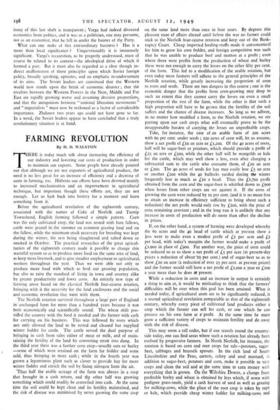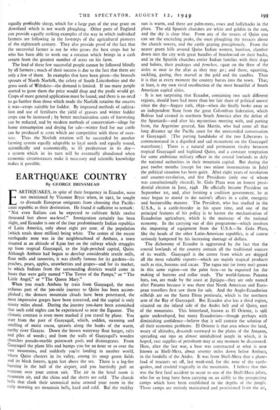FARMING REVOLUTION
By II. D. WALSTON
THERE is today much talk about increasing the efficiency of our industry and lowering our costs of production in order to maintain our exports. Some people have already pointed out that although we are not exporters of agricultural produce, the need is no less great for an increase of efficiency and a decrease of costs in farming, too. Hitherto our efforts have been devoted mainly to increased mechanisation and an improvement in agricultural technique, but important though these efforts arc, they are not enough. Let us look back into history for a moment and learn something from it.
Before the agricultural revolution of the eighteenth century, associated with the names of Coke of Norfolk and Turnip Townshend, English farming followed a simple pattern. Corn was the only cultivated crop, the land was rested with bare !allows, cattle were grazed in the summer on common grazing land and on the fallow, while the minimum stock necessary for breeding was kept during the winter, the rest being slaughtered and salted down or smoked in October. The practical researches of the great agricul- turists of the eighteenth century made it possible to change this wasteful system so as to produce more food on the same area of land, to keep more livestock, and to give steadier employment to agricultural. workers throughout the year. Thus we were able not only to produce more food with which to feed our growing population, but also to raise the standard of living in town and country alike by greater productivity and lower costs. An entirely new type of farming arose based on the classical Norfolk four-course rotation, bringing with it the necessity for the land enclosures and the social
and economic revolution that went With them. : The Norfolk rotation survived throughout a large part of England in unchanged form for more than a hundred years because it was both economically and scientifically sound. The wheat shift pro- vided the country with the food it needed and the farmer with cash for carrying on his business. This was followed by roots which not only allowed the land to be rested and cleaned but supplied winter fodder for cattle. The cattle served the dual purpose of bringing in cash from sales either of meat or milk, and of main- taining the fertility of the land by converting straw into dung. In the third year there was a further corn crop—usually oats or barley —some of which were retained on the farm for fodder and some sold, thus bringing in more cash ; while in the fourth year was grown a leguminous plant such as clover to provide hay for more winter fodder and enrich the soil by fixing nitrogen from the air.
'Thus half the arable acreage of the farm was always in a crop that brought in a cash return, and th.e other half was growing something which could readily be converted into cash. At the same time the soil could be kept clean and its fertility maintained, and the risk of disease was minimised by never growing the same crop on the same land more than once in four years. By degrees this pleasant state of affairs altered until before the war no farmer could stick to the Norfolk four-course rotation and keep out of the Bank- ruptcy Court. Cheap imported feeding-stuffs made it uneconomical for him to grow his own fodder, and foreign competition was such that he was unable to produce beef and mutton at a profit ; even where there were profits from the production of wheat and barley these were not enough to carry the losses on the other fifty per cent. of the farm. This led to a modification of the arable rotation, but even today most farmers still adhere to the general principles of the Norfolk rotation, while greatly increasing the proportion of corn to roots and seeds. There are two dangers in this course ; one is the economic danger that the profits from corn-growing may drop to such an extent that they cannot carry the losses on even a small proportion of the rest of the farm, while the other is that such a high proportion will have to be grown that the fertility of the soil suffers and the chance of disease increases. So long as we adhere, in no matter how modified a form, to the Norfolk rotation, we are putting upon our cash crops what will eventually prove to be the insupportable burden of carrying the losses on unprofitable crops.
Take, for instance, the case of an arable farm of 200 acres with 6o per cent. under seeds ; 120 acres of corn will, let us assume, show a net profit of Lzo an acre or £I,200. Of the 40 acres of roots, half will be sugar-beet or potatoes, which should provide a profit of £25 an acre or £500, while the other half will be mangolds or kale for the cattle, which may well show a loss, even after charging a substantial sum to the cattle who consume them, of Lb ° an acre or £200. The 40 acres of seeds for hay may easily lose £5 an acre or another £200 while the 40 bullocks yarded during the winter frequently lose as much as Do a head. Thus the Daoo profit obtained from the corn and the sugar-beet is whittled down to Lgoo when losses from other crops are set against it. If the costs of growing the corn were reduced by zo per cent. (and it is no mean feat to attain an increase in efficiency sufficient to bring about such a reduction) the net profit would only rise by £200, with the price of corn remaining constant ; and in the long run it is unlikely that any increase in costs of production will do more than offset the decline in prices.
If, on the other hand, a system of farming were developed whereby the 6o acres and the 40 head of cattle which at present show a loss were to make even a modest profit of £2 per acre and £2 per head, with today's margins the farmer would make a profit of £1,900 in place of £90o. Put another way, the price of corn could be reduced so as to show a net profit of Ls per acre (at present-day prices a reduction of abour'2o. per cent.) and of sugar-beet so as to show Zit) an acre (a reduction of over 25 per cent, at present prices) and the farmer would still have a net profit of Li,000 a year or Limo a year more than he does ár present.
While a reduction in costs and an increase in output is certainly a thing to aim at, it would be misleading to think that the farmers' difficulties will be over when this goal has been attained. What is needed today, if agricultural costs arc to be significantly reduced, is a second agricultural revolution comparable to that of the eighteenth century, whereby every piece of cultivated land produces either a crop which the farmer can sell for cash, or one which he can process on his own farm at a' profit. At the same time he must grow a sufficient variety of crops to maintain fertility and do away with the risk of disease.
This may seem a tall order, but if one travels round the country- side today, one can find areas where such a rotation has already been evolved by progressive farmers. In North Norfolk, for instance, the rotation is based on corn and root crops for sale—potatoes, sugar- beet, cabbages and brussels sprouts. In the rich land of South Lincolnshire and the Fens, carrots, celery and seed mustard, in addition to sugar-beet, potatoes and corn, make it possible to vary crops and clean the soil and at the same time to earn money with everything that is grown. On the Wiltshire Downs, a change from profitable barley and wheat is obtained by leys which, if sown with pedigree grass-seeds, yield a cash harvest of seed as well as grazing for milking-cows, while the place of the root crop is taken by rape or kale, which provide cheap wintcr fodder for milking-cows and
equally profitable sheep, which for a large part of the year graze on downland which is not worth ploughing. Other parts of England can provide equally striking examples of the way in which individual farmers are following in the footsteps of the agricultural pioneers of the eighteenth century. They also provide proof of the fact that the successful farmer is not he who grows the best crops but he who has been able to work out a rotation which brings in a cash return from the greatest number of acres on his farm.
The lead of these few successful people cannot be followed blindly by all farmers ; much of their success is due to the fact that there are only a few of them. In examples that have been given—the brussels sprouts of North Norfolk, the celery of South Lincolnshire and the grass seeds of Wiltshire—the demand is limited. If too many people started to grow them the price would drop and the profit would go. Crops of more general application must be found, and there is no need to go further than those which made the Norfolk rotation the success it was—crops suitable for fodder. By improved methods of cultiva- tion and use of fertilisers the yield of grasses and winter fodder crops can be increased ; by better mechanisation costs of harvesting can be reduced, and by modern methods of conservation—silage for home consumption and drying for sale—winter feed for our cattle can be produced at costs which arc competitive with those of over- seas. Thus the Norfolk rotation will be succeeded by another farming system equally adaptable to local needs and equally sound, scientifically and economically, as if4 predecessor in its day— a system which in its turn will be eventually abandoned when economic circumstances make it necessary and scientific knowledge makes it possible.































 Previous page
Previous page